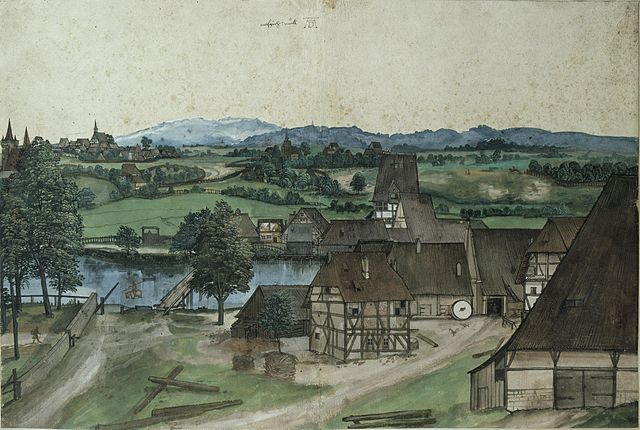Homepage › Forums › History › General Pre-Industrial History › 1360s Doublet Project › Reply To: 1360s Doublet Project
Yes, all fair points – and the precise guild politics and economic structure of each town could be radically different, even among the so-called guild towns.
Italy is different in some important ways, and the 14th Century is different. I am gradually acquiring a sense of it. We went to Sienna and Florence and a few other towns, and I saw the Artes still thriving in both marvelous places. But there are many differences, like the Italian towns had nobles in them and they were part of the family rivalries, which the German burghers derided as Hausmachtpolitik. I think maybe the German and Czech etc. burghers had more of a conscious sense of themselves as a separate estate outside of the feudal order.
I do think the non-citizens were people too, and mattered too, and so did the peasants. Some towns exploited the rural areas, Ulm and Bern come to mind, like forcing them to grow certain crops they wanted for their mills. And some of the Livonian towns. Though many others extended citizenship fairly far out into the countryside. Erfurt and the other towns of the Färberwaid paid the regional peasants very well for their woad, and they had a kind of symbiotic relationship with them. Strasbourg lent money to Alsatian peasants to set up vinyards so they could produce more wine. In Prussia and a lot of Poland, even the tiny market villages and the little cottage industry “towns” of less than 500 people (which often worked as sort of subcontractors for the “bigger”* cities) had a form of German town law, which extended to the Slavic, Prussian, and Kashubian residents and surrounding peasants, as well as the German speakers. The same was true for much of Swabia and the Rhineland, and parts of the northern fringe where the Hanse towns were.
For many of the servants, just being in the town gave them a much greater degree of safety. She wouldn’t have to worry so about the kind of arbitrary abuse of power or the violence of raids she might experience in the rural world. I have court records of a (quite lowly) bath-house attendant in Prague who won a court case against a squire who was backed up by a powerful noble, over someone else’s inheritance she didn’t even directly have to do with. There is another case in a little market town in the Tyrol where a woman, just the wife of a low-status artisan, was called a ‘hunden‘ by a visiting merchant, and she cut him with a knife. The court ruled in her favor and fined the man 6 groschen. In another case, a wealthy tavern owner was fined for yelling at and insulting two of his employees, a cook and a scullion. And this was a little town ruled over by an Abbot, but it still had a charter under town law, a variation on Litoměřice law. So he had to follow the rules.
By being in the town, that young scullion or cook might have an opportunity to get involved in some kind of business like brewing or peddling some kind of goods, or work in one of the many precursor ‘cottage industries’ such as spinning. Even if she never did advance herself much in life, there is a good chance that her kids, if she had any, could become apprentices and thereby move into the artisan or even the merchant estates.
Now the craft artisans could be oppressive to one another. Individual craft workshops were limited in how many apprentices or journeymen they could have but wealthy merchant artisans could contract out to dozens of poorer masters for a single contract or ongoing operation. The weavers in Augsburg was set up like that for example. Other towns were more egalitarian, with quite large middle classes of wealthier artisans, professionals, and lower ranking (local) merchants, based on the income levels I’ve seen – as much as 40%. That probably compares pretty well to the town where I live.
Peasants in the countryside also benefited from the towns quite a bit. Many towns like Nuremberg (and / or their citizens) had industrial operations like fulling mills, wire pulling and metal working mills, bloomery forges and so on scattered all over the countryside. The people (mostly men) who worked in these places were sometimes granted paleburgher status, meaning they could move into the town. And of course, many

This famous sketch by Dürer is a ‘Drahtziehmuehle’, a water powered wire puling mill, which Nuremberg set up about 30 miles outside of town. The finished spools of wire would be floated up the river to town where the skilled artisans could make armor, or clocks or whatever they were doing with it.
One of the biggest things, which I suspect was also true in Italian city states though I’m not certain, is that they had all that time off. Typical in German speaking or West-Slavic areas (Poland, Bohemia, Moravia, etc.) was 120 ‘Holy’ days per year. Even when they were working they got usually a day off plus half a day for the bath. Which is much better than workers in England or the US in much of the 19th Century, or today in places like Bangladesh.
*Caveat that a ‘big city’ in medieval Germany was about 30,000 souls, the biggest had maybe 50,000 at their zenith. So that’s another difference from places like Florence.
-
This reply was modified 4 years, 4 months ago by
Hans Hellinger.
-
This reply was modified 4 years, 4 months ago by
Hans Hellinger.
